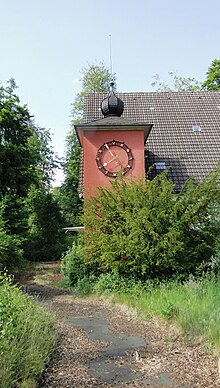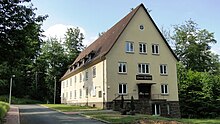Fritz Erler barracks
The Fritz-Erler-Kaserne was a barracks in Rothwesten , a district of the municipality Fuldatal near Kassel in Northern Hesse . It was built in 1934 as Rothwesten Air Base , first used by the US Army after the Second World War and then from 1972 to 2008 by the German Armed Forces . It was the location of the 1948 currency conclave , at which the currency reform in the western occupation zones was prepared.
Construction of the facility
Even before the German Air Force was founded on March 1, 1935 , concrete plans for its development were in place. An air base for a long-range reconnaissance group was planned in the Kassel area. Although there was already an airfield at the Kassel-Waldau airfield, its location and dimensions had proven to be unsuitable for the operation of an air base . Under the direction of Albert Kesselring , who at that time was Head of Department D in the Reich Aviation Ministry , a Ju 52 carried out aerial reconnaissance in the Kassel area in order to find a suitable site. The area between Rothwesten, Knickhagen and Gut Eichenberg was considered suitable. Since the Rothwesten domain and the neighboring forest were state property, there were no problems with the acquisition of the land. Since the air force was not allowed to exist at this point in time, the cover organization Deutsche Verkehrsfliegerschule (DVS) was the official client.
The construction of large airfields and air bases was carried out by a staff of architects and engineers in the Reich Aviation Ministry, and so the government master builder Werner Noel was entrusted with the construction of the air base in 1934. Construction management was initially set up in the Rothwesten village school, which is why the name Rothwesten Fliegerhorst came about. For the construction of the air base, in order to create an appropriately level area, soil up to a height of 7 m had to be removed on the east side, and since two thirds of the area was forest, it had to be cleared accordingly. There were three shifts, seven days a week. This created a runway 600 m wide and 800 m long (later the runway was extended to 1000 m in length). On the eastern edge of the runway, the technical structures such as a large aircraft yard, three hangars (later expanded to five), the command and image point were built. However, the hangars turned out to be too small for later aircraft types such as the Dornier Do 17 . The aircraft yard served the general overhaul, major inspections and the repair of the stationed machines. The command post was also where the picture post was located and this was where the flight briefings and the preparations for cross-country flights took place. In the picture area, the picture material was evaluated and cut into clear picture plans. The accommodation area was not built in the style of a barracks, but similar to a civil housing estate, and was made of beeches between the buildings. Because of the relative seclusion of the air base, a housing estate for married officers, NCOs and civil servants was built on the southern edge. The crew quarters consisted of 1-4 man rooms and were relatively spacious. The farm building consisted of two gabled buildings that were connected by the kitchen wing and contained the dining rooms and canteens for NCOs and men; it was awarded for its design in an architecture exhibition in Munich. Residents also had access to events in the farm building, because it was designed as a meeting place . The social facilities such as the bowling alley and the swimming pool were unusual for a military site at that time .
About 50 m in front of the guard there was a 3 m high bronze statue by Paul Wynand with the name Icarus , which represented a man raising an eagle . The wrought iron gate and the clock on the farm building, with forged signs of the zodiac as numerals, were created by the Kassel master blacksmith Heinrich Cornelius. On the outside wall of the officer's mess there is a sculpture made by the sculptor Andreas Schwarzkopf with the name “The knight guards the valley”.
History as Rothwesten Air Base
The Rothwesten Air Base was built for a long-range reconnaissance group, which was initially equipped with Heinkel He 45 , and the hangars were dimensioned accordingly. When the group was equipped with Heinkel He 70 and Dornier Do 17, the halls turned out to be too small.
On March 15, 1935, an advance command, consisting of three officers and 18-25 NCOs and crew ranks, arrived in Rothwesten to set up the 1st squadron. Since the buildings on the square were still in the rough, the men were initially temporarily housed in a barrack . On March 1, 1935, the "Fliegergruppe Kassel", with the designation 1./ Aufkl.Gr.424, was officially put into service (later then 1./ Aufkl.Gr.124). The topping-out ceremony for the barracks did not take place until April 30, 1935, when the "Fliegergruppe Kassel" had already been in service for a month. Since the airfield could not be used at first, the flight was from Kassel-Waldau; only when it was completed on May 1, 1935 was the flight from Rothwesten operated. From December 1, 1935, the school for volunteer pilot candidates began.
On April 1, 1936, the commissioning of two more squadrons resulted in the formation of the three squadrons group (F) 124, which was later renamed into reconnaissance group 24 and later into reconnaissance group 22. Between 1938 and 1939 this was subordinate to the reconnaissance wing 12 . The troop flag was handed over to the reconnaissance group on May 10, 1937. In 1937 the previous Heinkel He 45 was replaced by the Heinkel He 70, which in turn was replaced by the Dornier Do 17 in 1938.
After the outbreak of war in 1939, the reconnaissance squadrons were relocated to locations close to the front. After that, the air base briefly housed combat and night fighter units and for a long time the AB 119 pilot school. It turned out that the system was undersized for the space requirements of modern aircraft and their requirements under war conditions. The airfield now gained importance as an alternative production facility for the Kassel-based Gerhard-Fieseler-Werke , which used the halls to assemble aircraft from delivered assemblies and the space for flying in.
Shortly before the American troops occupied the air base on April 6, 1945, the Germans blew up parts of the facility - including the two assembly halls of the Fieseler company, a workshop building and the flight control.
History under allied use
After the air base was occupied, American troops initially continued to use it and expanded the area with paved runways and paved taxiways and parking areas. The stationing of squadrons of the 36th Fighter Group from April 1945 to February 15, 1946 and until April 9, 1946 of the 417th Fighter Squadron is known. After that, due to the proximity to the Soviet occupation zone, no more airborne units were stationed in Rothwesten, but instead it was used by American army troops and ground-based units of the US Air Force. The use is known by:
- Headquarters 1st Constabulary Regiment (1946–1947)
- 331st Communications Reconnaissance Company (1955–1972)
- A battery of the 6th Missile Battalion 517th Artillery (1966 - unknown)
- 601st US Air Force Aircraft Control and Warning Squadron (AC&W) (1949 – unknown)
- A company of 18th Army Engineers (period unknown)
Since the area was no longer used for aviation, the airfield was built with telecommunications systems and an anti-aircraft position.
In 1948, the Posen House, which was part of the barracks, hosted the currency conclave for planning the currency reform in West Germany.
Like all other military locations in North and Central Hesse, the Rothwesten military base was of particular strategic importance due to its geographical proximity to the Fulda Gap during the Cold War . On October 1, 1972, American troops left the site.
History as Fritz Erler barracks
On October 1, 1972, Resupply Company 40 moved into the former Rothwesten air base as the first Bundeswehr unit . On June 19, 1973 the telecommunications battalion 2 followed , which was relocated from Marburg to Rothwesten. In addition, the telecommunications training company 1/2, from June 2, 1973 a driving school, from 1975 the supply company 60 (previously supply company 340) and from October 1979 the 4th / maintenance battalion 2 were stationed in Rothwesten.
On February 22nd, 1975, the barracks were named Fritz Erler Barracks after the SPD politician Fritz Erler .
Due to the restructuring of the Bundeswehr, the barracks were closed in spring 2008.
Non-military use
The Museum Currency Reform 1948 , which deals with the history of the conclave, the currency reform and the history of the German currencies in post-war Germany , was established in the Posen building as early as 1993 .
After the Bundeswehr withdrew, the area fell to the Federal Agency for Real Estate Tasks (BImA). Together with the municipality of Fuldatal , to which Rothwesten has belonged since the Hessian regional reform in 1972, this dealt with the conversion of the site. For this purpose, parts of the building were sold to investors. A photovoltaic system was built on a 66-hectare open space, the former airfield, and roads and infrastructure were renewed and modernized.
During the refugee crisis in 2015 , refugee accommodation for up to 900 people was set up in the buildings of the former barracks, which was then closed again in autumn 2016. There was an attempted attack on the property that damaged gas pipes.
Individual evidence
- ↑ Reconnaissance Group 124
- ↑ a b Spiegel Online: Zapfenstreich in the Fulda-Gap
- ↑ HNA: Erler plant in Rothwesten: Development for 5.9 million euros soon to be completed , accessed on April 16, 2017.
- ↑ HNA: The future of refugee accommodation in the Kassel district is unclear , accessed on April 16, 2017.
- ↑ HNA: Rothwesten: Refugees leave Wednesday , accessed on April 16, 2017.
- ↑ HNA: Cut gas pipeline in Rothwesten: Only vague information after the attack , accessed on April 16, 2017.
literature
- Alfons Kössinger: From Rothwesten Air Base to Fritz-Erler-Kaserne 1934–1992 , self-published in 1992.
Web links
- Closure of the Fritz Erler barracks in Rothwesten / Fuldatal, December 31, 2007. Contemporary history in Hesse (as of July 12, 2012). In: Landesgeschichtliches Informationssystem Hessen (LAGIS). Hessian State Office for Historical Cultural Studies (HLGL), accessed on April 16, 2017 .
- Kassel-Rothwesten Air Base at fliegerhorste.de, accessed on April 16, 2017.
Coordinates: 51 ° 23 '22.6 " N , 9 ° 32'27.1" E




